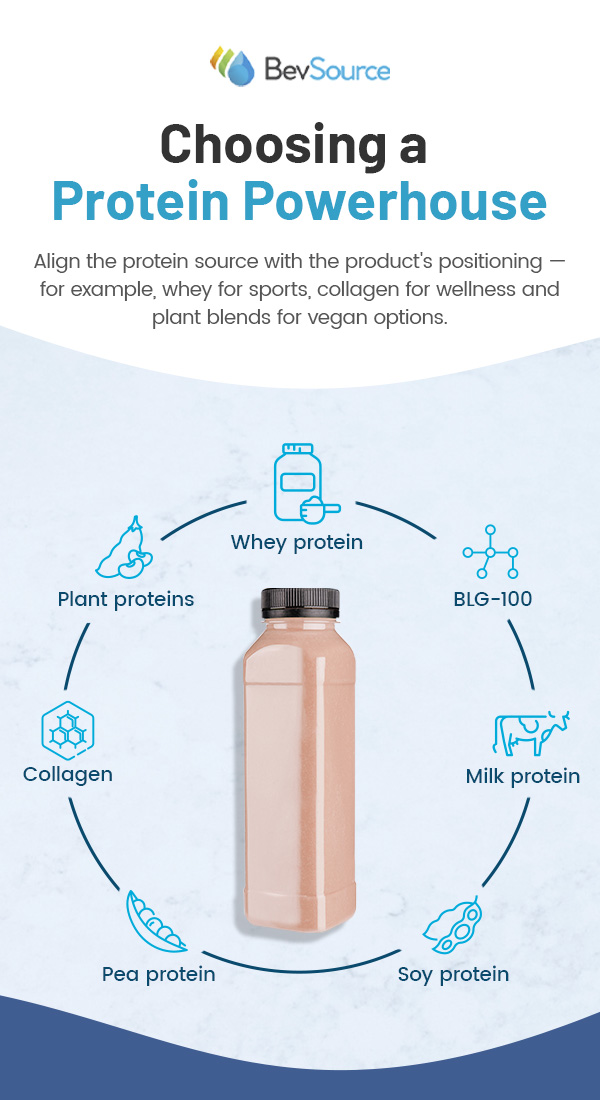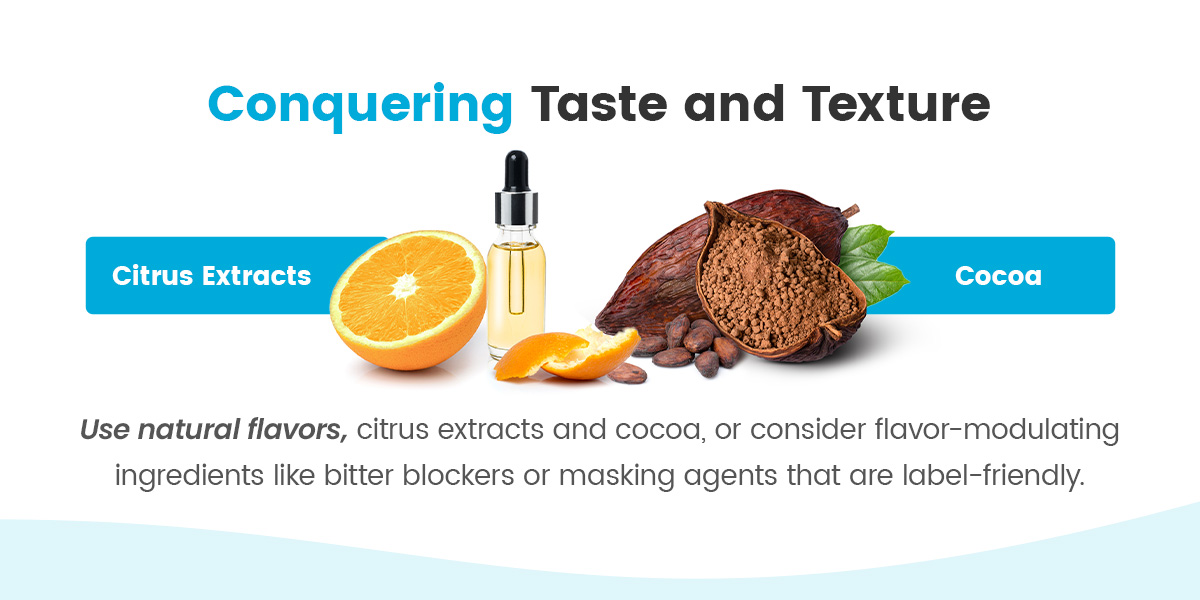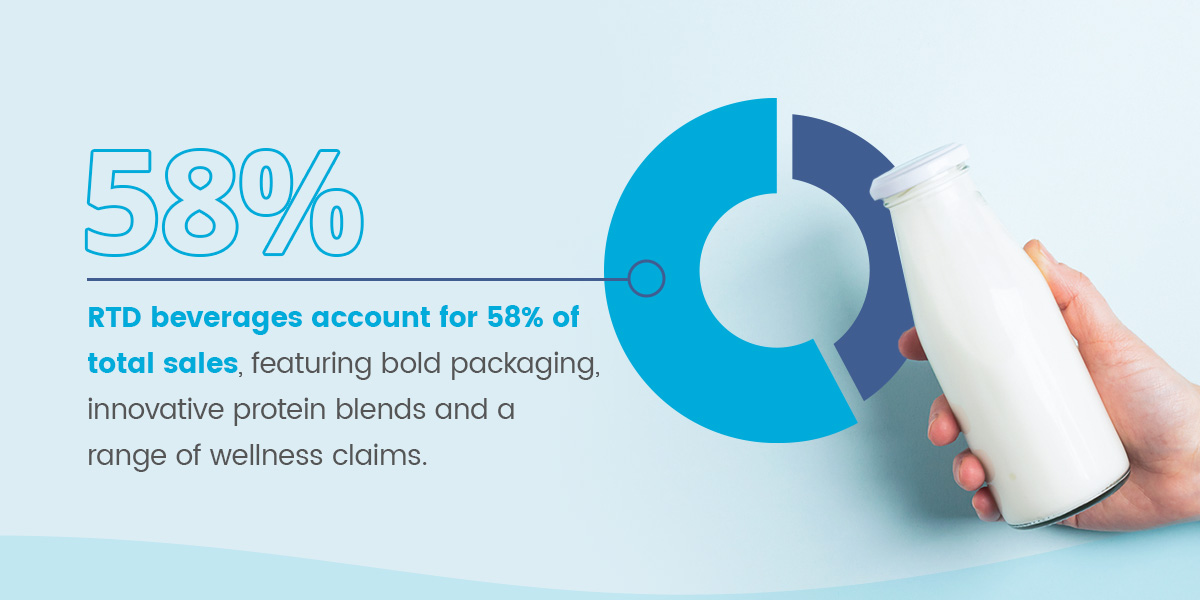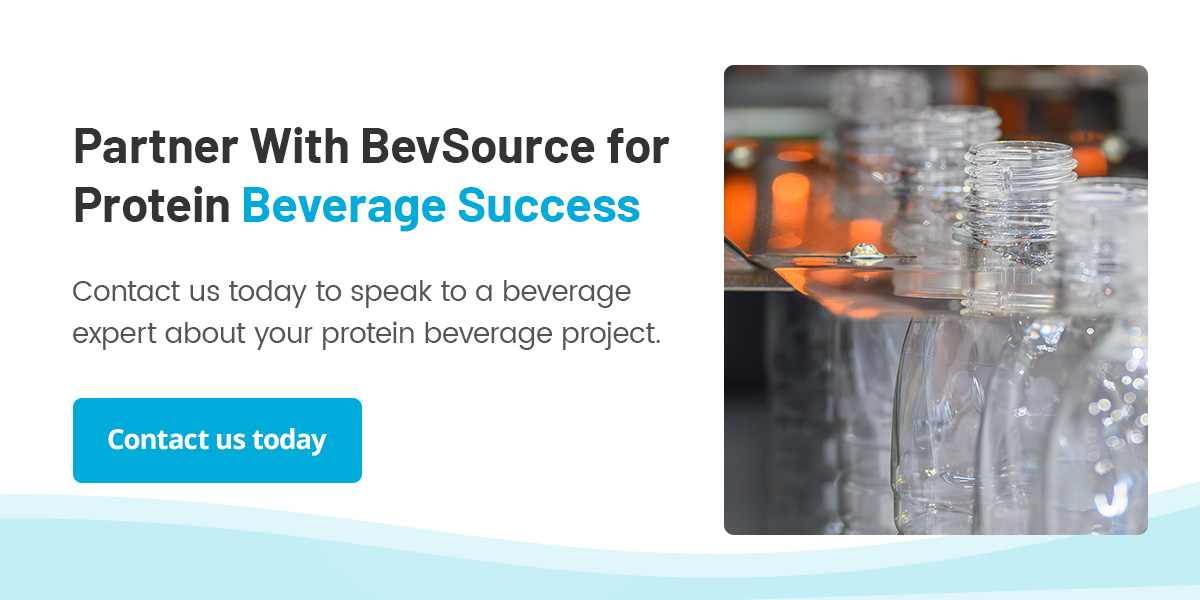Protein Beverages: Formulation Strategies for Success

Protein Beverages: Formulation Strategies for Success
Protein drinks are no longer niche sports products in a major beverage category. In North America, the sports and performance beverage category is growing steadily as consumers look for convenient ways to support active lifestyles, manage weight and meet their daily protein needs. High-protein functional beverages specifically are no longer just for athletes but have become a go-to choice for everyone, from busy professionals to wellness-minded consumers.
As this market matures, expectations are shifting toward transparency, quality, and experience. Formulators must balance high protein content and functional benefits with great taste, appealing texture, and reliable shelf stability.
For brands, success depends on three pillars — understanding market drivers, mastering formulation strategies and executing a thoughtful launch.
Market and Consumer Drivers of the Modern Protein Boom
The protein drink segment is booming as consumers seek products that align with evolving health priorities, values, and nutritional needs. Brands that recognize these forces can anticipate consumer expectations, reduce missteps and position themselves for growth.
- Health and wellness goals: Functional benefits are driving purchasing decisions as consumers seek out products that support their health goals, especially those linked to metabolic health, immune support, sustained energy and muscle recovery or maintenance.
- GLP-1s and nutrition gaps: The growing use of GLP-1 drugs for weight management is creating opportunities for high-protein beverages to support muscle preservation and adequate protein intake — some individuals fall short of protein needs due to reduced caloric intake.
- The plant-based movement: The increasing popularity of plant-based drinks remains strong. In 2024, 59% of United States households bought plant-based protein liquids, powders or ready-to-drink (RTD) beverages, highlighting the growing appeal of dairy alternatives and sustainable nutrition.
- Desire for natural, recognizable ingredients: Consumers want straightforward ingredients they understand and feel good about incorporating into their routines, which reinforces purchasing confidence and product trust. According to a Packaged Facts survey, 51% of respondents look for clean-label packaged foods.
- Trust and transparency: Beyond ingredients, clear labeling and honesty about sourcing and processing strongly influence brand loyalty — 60% of consumers, for example, state that clean label significantly impacts their buying decisions, including claims around no additives or preservatives and few or no artificial ingredients.
Together, these drivers underscore a broader shift toward authenticity, functionality and trust in protein beverages. Brands that meet these expectations — with clarity around formulation choices and performance benefits — will continue to capture a growing share of this dynamic category.
Formulation Strategies for Crafting a Successful Protein Beverage
To succeed, brands need formulation strategies that strike a balance between high nutritional performance and taste, texture, stability, and cost, while aligning with evolving consumer expectations.
Choosing a Protein Powerhouse

Choosing the right protein source requires consideration of nutritional quality, formulation challenges and market trends to ensure a product that meets both consumer expectations and technical requirements. Options include:
- Whey protein: The gold standard for protein, whey isolates and hydrolysates offer high bioavailability, rapid amino-acid delivery, and rich leucine to support muscle protein synthesis. Highly soluble, heat- and acid-stable, and with a smooth mouthfeel, whey is a staple in RTD and sports beverages. Hydrolysates boost solubility, reduce grittiness and can deliver low or nearly undetectable lactose for sensitive consumers. With a perfect or near-perfect Protein Digestibility Corrected Amino Acid Score, whey is a complete, highly digestible protein. It dissolves clearly at low pH without off-flavors, making it the preferred choice for high-protein, clear, stable RTDs. As a dairy protein, allergen considerations apply, and it's not suitable for vegan or plant-based claims — but its performance, functionality, and affordability make it a top choice for formulators. With significantly higher leucine — the primary muscle-building amino acid — BLG-100 is gaining traction in fitness and sports nutrition as a next-generation whey.
- Milk protein: Milk proteins are a mixture of whey and casein, typically found as milk protein concentrates or milk protein isolates in powders and beverages. Casein provides slower digestion and a creamy mouthfeel, while whey in the blend adds solubility and high-quality amino acids. The combination delivers beverages with sustained protein release and enhanced satiety. Milk proteins are ideal for meal-replacement drinks such as Boost and Ensure, dairy-style RTDs, and fortified milks. They perform best in beverages with a pH above 4.6 — shelf-stable low-acid products require retort processing into bottles or cans, or UHT (ultra-high temperature) aseptic packaging. Focus on sourcing from grass-fed or rBST-free sources to meet clean label standards.
- Soy protein: Soy is a legacy plant protein that offers a good amino acid profile. It has a prominent flavor, which, along with allergen concerns, can face some consumer resistance.
- Pea protein: Thanks to its allergen-friendly status, pea protein is the leading plant-based protein option. It is non-dairy, gluten-free, allergen-friendly and kosher, making it an attractive choice for inclusive formulations. While innovations have addressed many sensory challenges, formulators may still need flavor-masking strategies, especially when working with lower-quality suppliers that can present issues with aroma and texture. Historically, pea protein faced solubility challenges in acidic RTDs, but modern isolates and hydrocolloid technologies have largely overcome these limitations, enabling its use in sports hydration beverages, value-added waters and fruit juices.
- Collagen: Collagen peptides are popular in niche products focusing on beauty and joint health. However, marine and bovine collagen can have a distinct fishy, bitter or meaty taste. These are difficult to mask without flavors and sweeteners, giving formulators limited tools to improve taste while maintaining nutrition panel simplicity.
- Other plant proteins: Faba bean is an energizing plant protein with good solubility and texture. Mung bean has a refreshing taste and excellent functionality, while chickpea protein offers a neutral flavor and creamy texture. These plant proteins can be blended to get a complete amino acid profile and improve the beverage's sensory characteristics.
Develop your protein beverage with your audience in mind. Align the protein source with the product's positioning — for example, whey for sports, collagen for wellness and plant blends for vegan options. Consider the claims you want to support, such as “high-protein,” “gluten-free,” “dairy-free,” or “non-GMO,” as these can influence ingredient choice and labeling. Conduct sensory testing to ensure your formula hits the desired sensory targets such as mouthfeel, smell, and taste.
Conquering Taste and Texture

Taste and texture can be challenging, especially with plant-based proteins. To address this, use natural flavors, citrus extracts and cocoa, or consider flavor-modulating ingredients like bitter blockers or masking agents that are label-friendly. Combining plant proteins with milder ones, such as milk with pea or faba bean, helps reduce strong flavor edges.
Formulators can use hydrocolloids, such as gums, emulsifiers and thickeners such as pectin or xanthan gum, to achieve a smooth, “drinkable” texture. Acacia gum in particular is valued for being a natural, plant-derived ingredient compatible with vegetarian and vegan product profiles. Its prebiotic fiber content also aligns with current consumer interest in digestive health and functional benefits, reinforcing its desirability in transparent, wellness-oriented formulations.
Quality ingredients matter. Higher-quality isolates generally have fewer off-notes and better solubility, but cost more. Processing techniques for improving solubility or reducing bitterness can also impact taste.
The Sweet Science of Sugar Reduction
Consumers increasingly seek protein beverages with fewer added sugars and lower calories, but taste and mouthfeel remain critical. For clean-label products, it's important to reduce sugars without relying on artificial sweeteners, which can conflict with natural or clean positioning. Achieving the right balance often involves using natural sweeteners, flavor enhancers or texture-modulating ingredients to maintain sweetness and a satisfying mouthfeel.
- Natural high-intensity sweeteners: Stevia extracts are heat- and pH-stable in many formulations, while monk fruit offers strong sweetness at low dosages and good consumer perception. Blending sweeteners can create a more balanced sweetness profile without a strong aftertaste. Novel proteins like thaumatin can act as sweet proteins, improving flavor profiles in sugar-reduced beverages.
- Bulking agents and syrups: Mouthfeel can suffer as sweetness is reduced, leading to a thinner texture. Bulking agents such as fiber blends or oligofructose can help mimic that full sugar body. Used sparingly, certain fruit syrups can also add sweetness and texture.
- Taste modulation strategies: Using natural flavors, acids and salts to enhance sweetness perception by rounding out flavor and reducing off-notes. The sweet spot for sweetness might shift, and less may be more by managing other flavor enhancers and texture elements.
- Regulatory and labeling considerations: Natural sweeteners and bulking agents must be declared appropriately according to nutrition panel definitions in target markets.
It's recommended to conduct a pilot run, as scale production runs can reveal interaction between proteins, sweeteners and stabilizers. Source high-quality isolates or concentrates, and leverage strategic blends to address nutrition gaps. Combining proteins, sweeteners or texturizers often yields better sensory results than one ingredient alone, helping to ensure a balanced and appealing final product.
Launching a Protein Drink in a Crowded Landscape

The North American beverage market for protein drinks is increasingly competitive. The protein supplements market size is actively growing, and RTD beverages account for 58% of total sales, featuring bold packaging, innovative protein blends and a range of wellness claims.
Standing out requires more than a good, protein beverage formulation — it requires a deliberate go-to-market strategy built around differentiation, building trust and flawless execution to capture consumer attention and loyalty.
The protein beverage landscape is driven by consumer focus on health, convenience and functional benefits, with products tailored to meet lifestyles and nutritional needs. Brands that combine product innovation with clear brand messaging and strategic launches stand the best chance of thriving in this growing category.
Highlight Unique Functional Benefits
Functional differentiation helps cut through shelf noise. Beyond protein quantity, highlight specific benefits such as joint support from collagen, muscle recovery from high-leucine blends or satiety support for consumers using GLP-1 drugs. Clinical references or credible studies back up these benefits, and clear, evidence-based messaging reassures retailers and consumers.
Target a Niche Audience
A narrow positioning can accelerate traction, as broad messaging gets lost in a saturated category. However, it's crucial to align the product attributes with the target audience's priorities.
For example, a high-protein, low-sugar beverage with added collagen and iron can be marketed toward active women who are focused on metabolic health and wellness. Tailored messaging, portion sizes and flavor profiles for this audience create a distinct brand identity rather than a generic protein shake.
Further target market segments by partnering with influencers, certifying bodies or organizations trusted by that niche to signal authenticity.
Emphasize Natural Ingredients and Transparency
Transparency builds trust with buyers who scrutinize labels. Use recognizable proteins, natural sweeteners and lean-label stabilizers. Consider QR codes linking to sourcing information, sustainability stories or manufacturing certifications. Consistency between what the label says and what the consumer experiences is critical to repeat purchases.
Focus on sustainable sourcing, as using suppliers with documented sustainability practices reduces the risk of negative publicity about labor, environmental or ethical concerns. It also supports regulatory readiness, as more retailers require proof of ethical sourcing.
This step differentiates products. In a crowded functional beverage market, showing verifiable sustainability can set a brand apart and justify premium pricing.
Build a Resilient and Traceable Supply Chain
Ingredient shortages and price spikes can derail launches. Secure multiple, qualified suppliers for key proteins and sweeteners. Implement traceability measures to easily verify origin and quality at each step. This is an increasingly important factor for retailers, regulators and consumers. Early collaboration with suppliers also speeds up documentation for claims such as “non-GMO” or “organic.”
Ensure there are at least two suppliers per critical ingredient, and stagger geographic locations to reduce supply risk from weather or regulatory shifts. Finally, standardize ingredient specifications across suppliers.
Be Careful of Labeling, Claims and Regulatory Considerations
A clean nutrition panel doesn't exempt products from regulatory scrutiny. High protein claims must meet minimum thresholds, “natural” has different definitions across markets, and allergen and cross-contact risks must be disclosed. Work with regulatory specialists or third-party certifiers early to avoid costly relabeling or product withdrawals.
Find a Strategic Partner
Launching alone is risky. Strategic partners such as experienced co-manufacturers or full-service development businesses provide access to vetted networks, pilot facilities and supply chain intelligence. These partnerships reduce time to market, improve quality assurance and allow internal teams to focus on brand building and distribution.
Partner With BevSource for Protein Beverage Success
Protein beverages are one of the most promising growth areas in the functional drink category. Beverage companies that combine market drivers, solution-driven formulation strategies and thoughtful launch tactics with credible claims and trusted manufacturing partners are positioned to thrive.
With expert guidance from BevSource, your brand can bring a differentiated protein beverage to market with confidence. With vast experience, supplier vetting and beverage industry connections, we help your brand by creating innovative strategies to improve your market position.
Let's collaborate through every stage of beverage development, formulation and commercialization. Contact us today to speak to a beverage expert about your protein beverage project.

